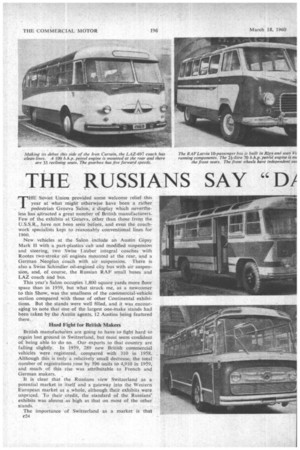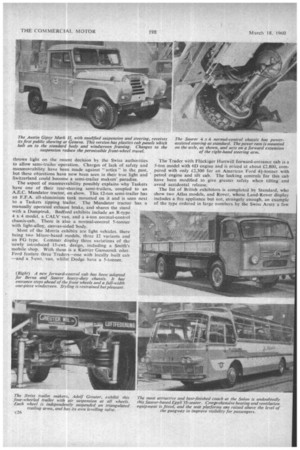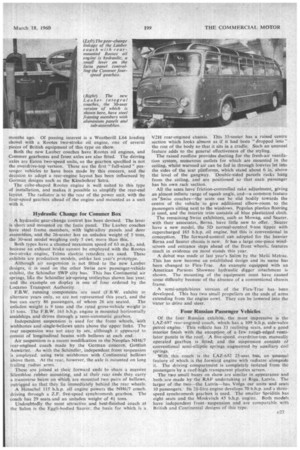THE RUSSIANS SAY "DI
Page 60

Page 61

Page 62

Page 63

If you've noticed an error in this article please click here to report it so we can fix it.
kT GENEVA
By ohn F. Moon,
A.M.I.R.T.E.
T. ,HE Soviet Union provided some welcome relief this year at what might otherwise have been a rather pedestrian Geneva Salon, a display which nevertheless has aAtracted a great number of British manufacturers. Few of the exhibits auGeneva, other than those from the U.S.S.R.,have not been seen before, and even the coachwork specialists kept to reasonably conventional lines for 1960.
New vehicles at the Salon include an Austin Gipsy Mark II with a part-plastics cab and modified suspension and steering, two Swiss Lauber integral 'coaches with Rootes two-stroke oil engines mounted at the rear, and a German Neoplan coach with. air .su.spension. There is also a SWiss Schindler oil-engined city bus with air suspension, and, of course, the Russian RAF small buses and LAZ coach and bus.
This year's Salon occupies 1,800 square yards more floor space than in 1959, but what struck me, as a newcomer to this Show, was the smallness of the commercial-vehicle section compared with those of other Continental exhibitions. But the stands were well filled, and it was encouraging to note that one of the largest one-make stands had been taken by the Austin agents, 12 Austins being featured there.
Hard Fight for British Makers British manufacturers are going to have to fight hard to. regain lost ground in Switzerland, but most seem confident of being able to do so. Our exports to that country are falling slightly. In 1959, 289 new .British commercial vehicles were registered, compared with 310 in 1958. Although this is Only a relatively small decrease, the total number of registrations Jose by 596 units to 4,910 in 1959, and much of this rise was attributable to French and German makers. ..
It is clear that the Russians view Switzerland as a potential market in 'itself and a gateway into the Western European market as a whole, although their exhibits were unprieed. To their credit, the standard of the Russians' exhibits was almost as high as that on most of the other stands.
The importance of Switzerland as a market is that c24
vehicles of all makes compete under identical conditions, enabling direct comparisons to be made. This point was emphasized by Dr. Heinz Nordhoff,director-general of the German Volkswagen concern, on the opening day of the Salon. In his opinion, important general trends became
apparent first in Switzerland. If this is so, the more attention our makers pay to Switzerland the better, although whether the trends are strongly, pronounced is sometimes open to doubt.
Nine British makes are on show this year. Austin exhibits include three Gipsys, all with the new suspension and steering layciut, and three 7-tonners with attractive locally built cabs with entrance steps ahead of the front wheels.Two of the new FG forward-control models which, like the 7-tonners, are fitted with exhaust brakes, are shown. An A35 van, two 152 vehicles, and a forward-control tractor chassis with Icammell semi-trailer complete the Austin display.
This articulated unit is shown as a working exhibit, and
throws light on the recent decision by the Swiss authorities to allow semi-trailer operation. Charges of lack of safety and manceuvrability have been made against " attics " in the past, but these objections have now been seen in their true light and ' Switzerland could become a semi-trailer makers' paradise.
The aspect of manceuvrability possibly explains why Taskers have one of their rear-steering semi-trailers, coupled to an A.E.C. Mandator tractor, on show. This 12-ton semi-trailer has an F.F.A. all-aluminium tank mounted on it and is seen next to a Taskers tipping trailer. The Mandator tractor has a manually operated exhaust brake, and shares the stand with a Dumptruk. Bedford exhibits include an R-type 4 x 4 model, a CALV van, and a 4-ton normal-control chassis-cab. There is also a normal-control 5-tonner with light-alloy, canvas-sided 'body.
Most of the Morris exhibits are light vehicles, there being two Minor-based models, three 72 variants and an FG type. Commer display three variations of the newly introduced 15-cwt. design, including a Smith's mobile shop. With these is a Karrier Gamecock oiler. Ford feature three Traders—one with locally built cab —and a 5-cwt. van, whilst Dodge have a 5-tonner. The Trader with Fliickiger Huttwill forward-entrance cab is a 5-ton model with 60 engine and is priced at about £2,800, compared with only £2,300 for an American Ford 41-tonner with petrol engine and tilt cab. The locking controls for this cab have been modified to give greater safety when tilting and avoid accidental release.
The list of British exhibitors is completed by Standard, who show two Atlas models, and Rover, whose Land-Rover display includes a fire appliance but not, strangely enough, an example of the type ordered in large numbers by the Swiss Army a few months ago. Of passing interest is a Weatherill L64 loading shovel with a Rootes two-stroke oil engine, one of several pieces of British equipment of this type on show.
Both the new Lauber coaches have Rootes oil engines, and Commer gearboxes and front axles are also fitted. The driving axles are Eaton two-speed units, so the gearbox specified is not the overdrive-top version. These are the first full-sized" passenger vehicles to have been made by this concern, and the decision to adopt a rear-engine layout has been influenced by German designs such as the Kassbohrer Setra.
The cube-shaped Routes engine is well suited to this type of installation, and makes it possible to simplify the rear-end layout. The radiator is to the rear of the power unit, with the four-speed gearbox ahead of the engine and mounted as a unit with it.
• Hydraulic Change for Commer Box A hydraulic. gear-change control has been devised. The lever is short and mounted on the facia panel. The Lauber coaches have steel frame members, with light-alloy panels and door assemblies; and the 26-seater has an unladen weight of 5-tons, the 30-seat model weighing only 5 cwt. more than this.
Roth types have a claimed maximum speed of 63 m.p.h., and, because an exhaust brake cannot be employed with the Rootes two-stroke engine, Telma electric retarders are used. These exhibits are production models, unlike last year's prototype.
Although air suspension is not fitted to the new Lauber designs, it is used on the other Swiss new passenger-vehicle exhibit, the Schindler SWP city bus. This has Continental air springs, like the Schindler air-sprung trolleybus shown last year, and the example on display is one of four ordered by the Locarno Transport Authority.
F.B.W. running components are used (F.B.W. exhibit in alternate years only, so are not represented this year), and the bus can carry 86 passengers, of whom 26 are seated. The unladen weight is 9 tons and the rated gross-vehicle weight is 15 tons. The F.B.W. 165 .b.h.p. engine is mounted horizontally amidships and drives through a semi-automatic gearbox.
Independent suspension is used for the front wheels, with wishbones and ,single-bellows units above the upper lints. The rear suspension was not easy to see, although it appeared to consist of longitudinal beams with bellows at each end..
Air suspension is a recent modification to the Neoplan N116/7 rear-erigined coach made by the German concern, Gottlob Auwarter. As with the Schindler, independent front suspension is employed. using twin wishbones with Continental bellows above them. At the rear, however, the axle is mounted on long trailing radius" arms.
These. are joined at their forward ends to share a massive Sitentbloc rubber mounting, and at their rear ends they carry a transverse beam on Which are mounted two pairs of bellows, outrigged so that they lie immediately behind the rear wheels.
A Henschel 115 b.h.p. oil engine powers the N146/7 coach. driving through a Z.F. five-speed synchromesh gearbox. The coach has 29 seats and an unladen weight of 44 tons.
Undoubtedly the most attractive and best-finished coach at the Salon is the Eggli-bodied Saucer, the basis for which is a V21-1 rear-engined chassis. This 35-seater has a raised centre section which looks almost as if it had been "dropped into" the rest of the body so that it sits in a cradle. Such an unusual feature adds to the general effectiveness of the styling.
The raised roofline provides ducting for the fresh-air ventilation system, numerous outlets for which are mounted in the ceiling, whilst warmed air can be fed in through louvres let into the sides of the Seat platforms, which stand about 6 in. above the level of the gangway. Double-sided parcels racks hang from the ceiling, and are positioned so that each passenger
has his own rack -section. "
All the seats have friction-controlled rake adjustment, giving an almost infinite range of squabangle, and—a common feature on'Swiss coaches—the seats can be slid bodily towards the centre of the vehicle to give additional elbow-room to the passengers sitting next to the windows., Pegulan plastics flooring is used, and the interior trim consists of blue plasticized cloth.
The remaining Swiss exhibitors, such as Mowag, and Saurer, with their associates, Berna, have little new to offer. Saurer have a new model, the 5D normal-control 9-ton tipper with supercharged 165 b.h.p. oil engine, but this is conventional in conception. The forward-control cab adopted for the heavier germ. and Saurer chassis is new. It has a large one-piece windscreen and entrance Steps ahead of the front Wheels; features much in evidence on most stands this year.
A debut was made at last year's Salon by the Meili Metrac. This has now become an established design and its name has been changed to Flex-Trac. An example equipped with an American Parsons Shawnee hydraulic digger attachment is shown. The mounting of the equipment must have caused some difficulty because of the absence of a conventional chassis frame.
A semi-amphibious version of the Flex-Trac has been developed. This has two small propellers on the ends of arms extending from the engine cowl. They can be Lowered into the water to drive and steer.
Four Russian Passenger" Vehicles
Of the four Russian exhibits, the most impressive is the
LAZ-697 rear-engined coach, which has a 109 b.h.p, side-valve petrol engine. This vehicle has 33 reclining sea Es. and-a good interior finish with the exception, of a few rough-edged ventilator panels in the roof.--A five-speed, overdrive-top, manually operated gearbox is fitted, and the suspension consists of conventional semi-elliptic springs augmented by auxiliary coil springs.
With this coach is the fAZ-652 25-seat •bus, an unusual feature of which is the forward engine with radiator. alongside it The driving' compartment is completely isolated from the passengers by a roof-high transparent plastics screen.
The two small busts on show are similar in appearance and both are made by the RAE undertaking at Riga, Latvia. The larger of the two—the. Latvia—has Volga car units and seals 10 passengers:Its 24-litre engine develops 70 b.h.p. and a three speed synchromesh gearbox is used. The smaller Spriditis has eight seats and the Moskvitch 45 b.h.p. engine. Both models have independent front, suspension and are comparable with British and Continental designs of this type.
























































































































